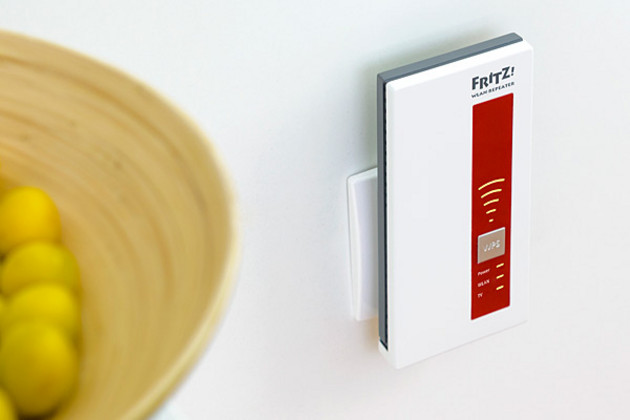Everything you need to know about Wi-Fi
AVM Content

Current data shows that in 2023, around 92% of all households in Germany had an internet connection, which corresponds to around 40 million households. Of these connections, most households use Wi-Fi to distribute their internet access throughout the home. And that's no surprise, as a Wi-Fi connection is established in no time and enables high transmission rates, and because practically every terminal device comes with a Wi-Fi module or can be supplemented with a wireless USB client.
But this wasn't always the case. At the dawn of the DSL age, internet connections were established via LAN cable, before Wi-Fi proved to be a more impressive alternative. Besides, there are all kinds of Wi-Fi: the technology keeps evolving, with its progress marked by a variety of standards. This article takes a closer look at the different standards and offers other interesting facts about Wi-Fi.
What is Wi-Fi?
Wireless LAN, which is commonly called Wi-Fi, is short for "Wireless Local Area Network". The technology enables end devices such as tablets, PCs or smartphones to establish a wireless connection to a wireless radio network. To establish a Wi-Fi network, you need a router that supports Wi-Fi (for example the FRITZ!Box 7690). It receives the incoming DSL, cable or LTE signal and forwards it to corresponding devices within range.
Aside from this, the wireless connection works the same way a cable-based network does: Wi-Fi devices register and exchange data with the router. The advantages are obvious: you don't need cables and you can roam freely throughout the coverage area with your smartphone or handheld device without losing signal. The devices also reconnect automatically when they return to the Wi-Fi coverage area. The established WPA3 encryption method featured in all FRITZ!Box models keeps Wi-Fi connections safe. All Wi-Fi networks are secured by an individual network key upon delivery.
What are the advantages of dual-band or tri-band Wi-Fi?
Since Wi-Fi is a radio network, radio signals need to be transmitted on a certain network or frequency range. The 2.4 GHz network has been a standard for years. This means that all wireless devices in the home network use this frequency, which not only results in a lot of traffic due to the quantity of hardware, but can also lead to interference between the devices. An alternative to the 2.4 GHz band is the 5 GHz band, which is subject to much lower interference when it comes to Wi-Fi.
When Wi-Fi 5 (802.11ac) was introduced in 2013, it kick-started a broader utilization of 5-GHz Wi-Fi networks, wherever a corresponding client was available. Dual Wi-Fi means that the FRITZ!Box is able to serve connected devices on both channels concurrently. And when the technology inside the Wi-Fi router enables it to decide autonomously which band to use for which device and to switch accordingly, this is called band steering.
With the introduction of tri-band Wi-Fi, an additional band at 6 GHz became usable. This allows routers to transmit simultaneously on three frequency bands – 2.4 GHz, 5 GHz and 6 GHz – such as the FRITZ!Box 5690 Pro. The additional frequencies of the 6 GHz band enable even faster connections and greater stability because more space is available for data transmission.
What standards are there?
The newest Wi-Fi standard is called Wi-Fi 7, which ensures even faster data transfer, higher capacity and lower latency, especially when multiple devices are active in the network at the same time. The most significant advance is the aforementioned use of the 6 GHz band, which provides even more bandwidth and reduces interference. Wi-Fi 7 introduces Multi-Link Operation (MLO) technology, which allows a device to use multiple connections across different frequency bands at the same time. This ensures more efficient use of all available channels and significantly improves network stability and speed – making it ideal for data-intensive applications such as 4K or 8K streaming and cloud gaming.
Wi-Fi 7 has a few predecessors, each of which offered new possibilities when they came out. Here's a list of the most important standards:
|
IEEE 802.11b, g, a |
These three older wireless standards are not really in demand today, but they helped wireless internet breakthrough in the 2010s. |
|
Wi-Fi 4 |
IEEE 802.11n, Wireless N or Wi-Fi 4? They all mean the same thing: The wireless standard from 2009 remains the backbone of Wi-Fi in the 2.4 GHz frequency band. |
|
Wi-Fi 5 |
Dating from 2013, Wi-Fi 5 (IEEE 802.11ac) ensures high Wi-Fi speeds in the 5-GHz range. The standard has been retroactively labeled as Wi-Fi 5. |
|
Wi-Fi 6 |
Wi-Fi 6 (IEEE 802.11ac) is the first wireless standard to use the numbering system in its name. Wi-Fi 6 is the new name for Wireless AX. It has a number of clever tricks up its sleeve to provide multiple devices with fast Wi-Fi Wi-Fi 6 is designed to distribute the available bandwidth in the Wi-Fi network in the most efficient way. Find out more about Wi-Fi 6 in our guide article. |
|
Wi-Fi 6E |
Wi-Fi 6E extends the existing Wi-Fi 6 (802.11ax) standard and enables access to the new 6 GHz band. Wi-Fi 6E takes the efficient features of Wi-Fi 6 and transfers them to the 6 GHz band to provide more contiguous spectrum and less interference. With Wi-Fi 6E, enterprises are able to address new use cases that require multi-gigabit speeds such as high-definition video. |
|
Wi-Fi 7 |
Wi-Fi 7 (IEEE 802.11be) is the latest standard from the Wi-Fi Alliance, which defines new functional features. Wi-Fi 7 builds on Wi-Fi 6E (uses the 6 GHz band) and increases data rates by using 320 MHz channels. It also increases download speeds, responsiveness and reliability. |










